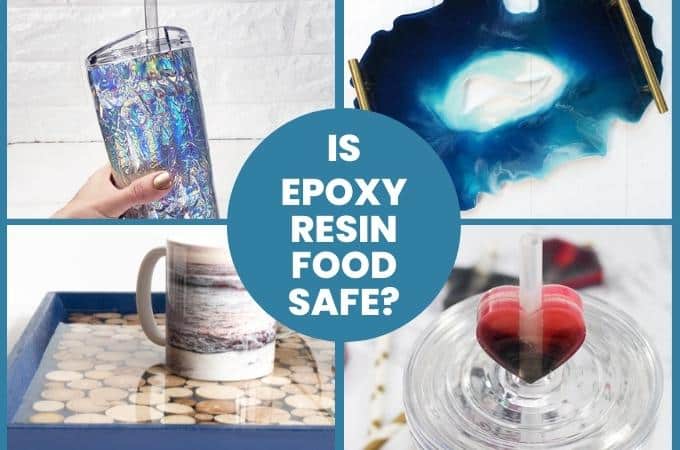Is Resin Safe To Eat Off Of

The allure of handcrafted items, especially those that come into contact with food, is undeniable. But when that craftsmanship involves resin, a synthetic material prized for its durability and aesthetic appeal, a critical question arises: is it safe to eat off of resin surfaces? This query isn't merely about aesthetics; it’s about public health, potentially affecting countless individuals who unknowingly use resin-coated cutting boards, serving platters, or even children's dinnerware.
This article delves into the multifaceted issue of food safety concerning resin-based products. We will examine the chemical composition of various resins, investigate the potential for leaching and contamination, and explore the regulatory landscape surrounding resin use in food-contact applications. Ultimately, our goal is to provide readers with a comprehensive understanding of the risks and considerations associated with using resin for food-related purposes.
Understanding Resin Chemistry
Resin is a broad term encompassing a variety of synthetic polymers, each with unique chemical properties. Epoxy resins, polyurethane resins, and polyester resins are among the most common types used in crafting and manufacturing.
Each resin type has a distinct chemical structure and curing process. This influences its hardness, durability, and, crucially, its potential for interacting with food.
The Curing Process: A Critical Factor
The curing process, during which liquid resin hardens into a solid, is paramount to its safety. Incomplete curing can leave behind residual monomers and other potentially harmful substances that can leach into food.
This is especially concerning with epoxies, which require precise mixing ratios and controlled temperature for proper polymerization. According to the U.S. Food and Drug Administration (FDA), proper curing is a key step in ensuring the safety of epoxy resins intended for food contact.
Leaching and Migration: Potential Health Risks
Even when fully cured, some resins can still leach chemicals into food, especially under certain conditions. Heat, acidic foods, and prolonged contact can accelerate this process.
The specific chemicals that leach depend on the type of resin and its formulation. Some of the more concerning compounds include bisphenol A (BPA), phthalates, and various monomers.
These substances have been linked to a range of health problems, including endocrine disruption, reproductive issues, and even certain cancers, according to numerous studies published by the National Institutes of Health (NIH).
The Role of Food Type and Temperature
The type of food in contact with the resin surface also plays a significant role in leaching. Acidic foods, such as citrus fruits or tomatoes, can be more aggressive in extracting chemicals from the resin.
Similarly, higher temperatures can increase the rate of leaching. Serving hot foods on resin platters is generally discouraged due to this risk.
Regulatory Oversight and Consumer Protection
The use of resins in food-contact applications is subject to regulatory oversight in many countries. The FDA in the United States, for instance, has specific regulations regarding the types of resins that can be used and the conditions under which they are considered safe.
However, these regulations primarily apply to commercially manufactured food containers and utensils, not necessarily to handcrafted items made by individual artisans. This leaves a significant gap in consumer protection.
The Importance of Food-Grade Certifications
Some resins are specifically formulated and certified as "food-grade," meaning they meet certain standards for safety in contact with food. These resins are typically tested for migration of harmful substances.
When purchasing resin products intended for food use, it's crucial to look for these certifications. However, even food-grade resins should be used according to the manufacturer's instructions.
Multiple Perspectives: Artisans and Consumers
Artisans who work with resin often emphasize the importance of using high-quality materials and following best practices for curing. Many believe that properly cured resin is safe for food contact, citing their own experiences and the experiences of their customers.
However, consumers have expressed increasing concerns about the potential health risks. They worry about the lack of transparency in the crafting process and the difficulty in verifying the safety of handcrafted resin items.
Navigating the Grey Areas
The current landscape presents several grey areas. The lack of consistent labeling requirements and the absence of comprehensive testing for handcrafted resin products leave consumers vulnerable.
Many consumers rely on anecdotal evidence or the assurances of artisans, which may not be sufficient to guarantee safety.
Moving Forward: Towards Safer Practices
Addressing the concerns surrounding resin and food safety requires a multi-pronged approach. More stringent regulations, clearer labeling requirements, and increased consumer education are essential.
Artisans should prioritize using food-grade resins and providing detailed information about the materials and curing processes they employ. Third-party testing and certification can also help build consumer trust.
The Future of Resin in Food-Contact Applications
The future of resin in food-contact applications depends on the industry's ability to address the current safety concerns. Innovation in resin formulations, improved curing techniques, and greater transparency are all crucial steps.
Ultimately, the goal should be to ensure that consumers can enjoy the aesthetic appeal of resin products without compromising their health. By embracing safer practices and promoting greater awareness, the resin industry can build a more sustainable and trustworthy future.


















